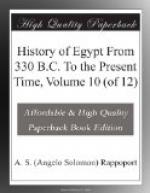The Alexandrian men of science and letters maintained themselves, some few by fees received from their pupils, others as professors holding salaries in the museum, and others by civil employments under the government. There was little to encourage in them the feelings of noble pride or independence. The first rank in Alexandria was held by the civil and military servants of the crown, who enjoyed the lucrative employments of receiving the taxes, hearing the lawsuits by appeal, and repressing rebellions. With these men the philosophers mixed, not as equals, but partaking of their wealth and luxuries, and paying their score with wit and conversation. There were no landholders in the city, as the soil of the country was owned by Egyptians; and the wealthy trading classes, of all nations and languages, could bestow little patronage on Greek learning, and therefore little independence on its professors.
Philadelphus was not less fond of paintings and statues than of books; and he seems to have joined the Achaian league as much for the sake of the pictures which Aratus, its general, was in the habit of sending to him, as for political reasons. Aratus, the chief of Sicyon, was an acknowledged judge of paintings, and Sicyon was then the first school of Greece. The pieces which he sent to Philadelphus were mostly those of Pamphilus, the master, and of Melanthius, the fellow-pupil, of Apelles. Pamphilus was famed for his perspective; and he is said to have received from every pupil the large sum of ten talents, or seven thousand five hundred dollars, a year. His best known pieces were, Ulysses in his ship, and the victory of the Athenians near the town of Phlius. It was through Pamphilus that, at first in Sicyon, and afterwards throughout all Greece, drawing was taught to boys as part of a liberal education. Neacles also painted for Aratus; and we might almost suppose that it was as a gift to the King of Egypt that he painted his Sea-fight between the Egyptians and the Persians, in which the painter shows us that it was fought within the mouth of the Nile by making a crocodile bite at an ass drinking on the shore.
Helena, the daughter of Timon, was a painter of some note at this time, at Alexandria; but the only piece of hers known to us by name is the Battle of Issus, which three hundred years afterwards was hung up by Vespasian in the Temple of Peace at Rome. We must wonder at a woman choosing to paint the horrors and pains of a battle-piece; but, as we are not told what point of time was chosen, we may hope that it was after the battle, when Alexander, in his tent, raised up from their knees the wife and lovely daughter of Darius, who had been found among the prisoners. As for the Egyptians, they showed no taste in painting.
[Illustration: 137.jpg METHOD OF EGYPTIAN DRAFTSMANSHIP]




